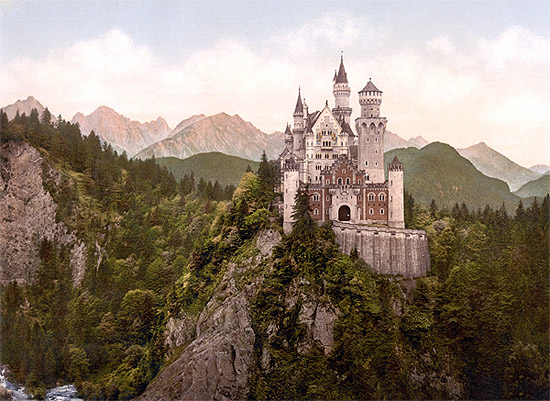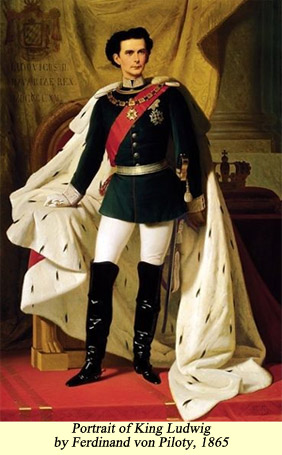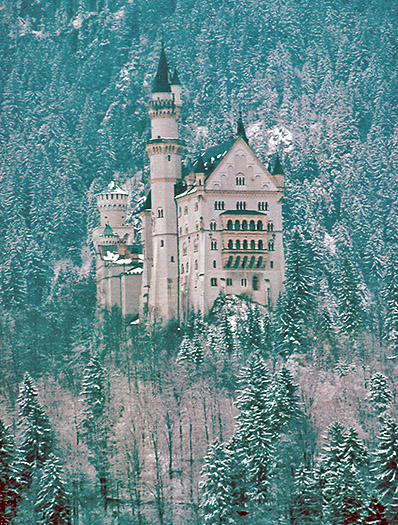King Ludwig's Castle
by Roger Kaza
Today, a swan on a mountain. The University of Houston's Music School presents this program about the machines that make our civilization run, and the people whose ingenuity created them.
My computer's desktop photo is a panorama of the Bavarian Alps, near a place called the Pöllat gorge. It looks like a craggy wilderness untouched by humans, except for one small peak. Atop that knoll, like some outlandish outcropping, sits the fairy-tale castle of Neuschwanstein. You've seen its towers and turrets a million times; it's the real-world Disney castle. Once upon a time, a tour bus dropped me off on the side of the mountain. It was snowing and the bus couldn't go any further. So I trudged up a slippery stone path, half-expecting to be stopped by a knight on horseback.

1890's photocrom print of Neuschwanstein castle
But there aren't any knights at Neuschwanstein castle. There never were. The castle looks like medieval fortress, but it's actually an extravagant monument to the inner child of a nineteenth century king, Ludwig II. As a boy Ludwig spent his summers at his father's fantasy castle, Hohenschwangau, where he fed the wild swans in the forest. At 13, he heard his first opera by Richard Wagner, the story of Lohengrin, the mysterious swan-knight. The swan became Ludwig's totem, and at 21 he commissioned Neuschwanstein, the "New-Swan-Stone" palace. He called the alpine site he chose for it "holy and unapproachable."
 Perhaps Ludwig dreamed he would rule all of Bavaria from his new castle. But the Seven Weeks War of 1866 and the Franco-Prussian War four years later put Bavaria under the reign of King Wilhelm I of Prussia. Greater Germany was united at last, and the Swan King, as Ludwig is sometimes called, retreated further and further into a mythic German past. He became Wagner's patron, settling the composer's massive debts and funding the construction of the theater in Bayreuth to present Wagner's operas.
Perhaps Ludwig dreamed he would rule all of Bavaria from his new castle. But the Seven Weeks War of 1866 and the Franco-Prussian War four years later put Bavaria under the reign of King Wilhelm I of Prussia. Greater Germany was united at last, and the Swan King, as Ludwig is sometimes called, retreated further and further into a mythic German past. He became Wagner's patron, settling the composer's massive debts and funding the construction of the theater in Bayreuth to present Wagner's operas.
And the castle itself is operatic: instead of an architect, Ludwig hired a theatrical set designer to create it. Despite the 13th century Romanesque appearance, it came with all the latest in home-improvements, including flush toilets, heating pipes on all floors, and electricity. The gilded throne room represents the Grail Hall from Parsifal, with the 12 apostles and Jesus symbolically conferring heavenly authority to Ludwig's earthly kingship. Throughout the castle, tapestries depict scenes from other Wagner works, and the swan motif is ever-present. The King spared no expense: the woodcarving in his private quarters is so elaborate it supposedly took 14 craftsmen over four years to complete.
And yet, for all its grandeur, Neuschwanstein has always struck me as an ineffably sad place. Perhaps it's King Ludwig's puzzling death at only age 40, leaving his castle unfinished to this day. Or perhaps it's the weight of the century that followed his — the noble dream of a greater Germany becoming the nightmare of two World Wars. Neuschwanstein is less than 150 years old, but it might as well be a thousand. Today kings are ceremonial, and castles are museums. The swan on the mountain is a magnificent reminder of an ancient road we have permanently detoured.
I'm Roger Kaza, at the University of Houston, where we're interested in the way inventive minds work.

Castle in Snow (R. Kaza)
(Theme music)
Official Site of Neuschwanstein Castle.
Site with many great picture of the castle's interior.
Wikipedia article on Ludwig II.
Wikipedia article on Lohengrin.
Images courtesy Wikimedia Commons.
End Music: Prelude to Lohengrin, Act I. Claudio Abbado conducts the Vienna Philharmonic (Deutsche Grammophon 437808-2)